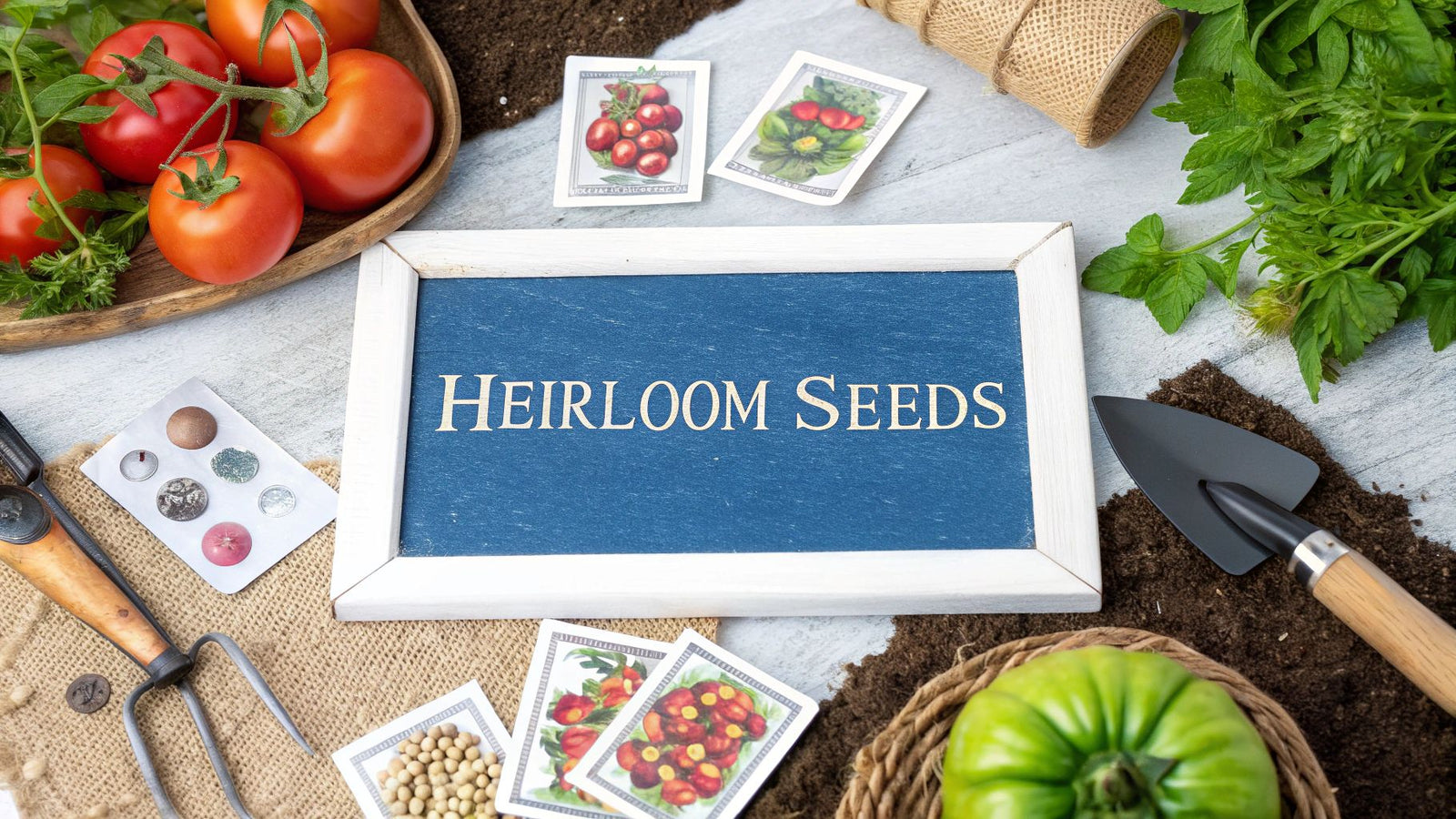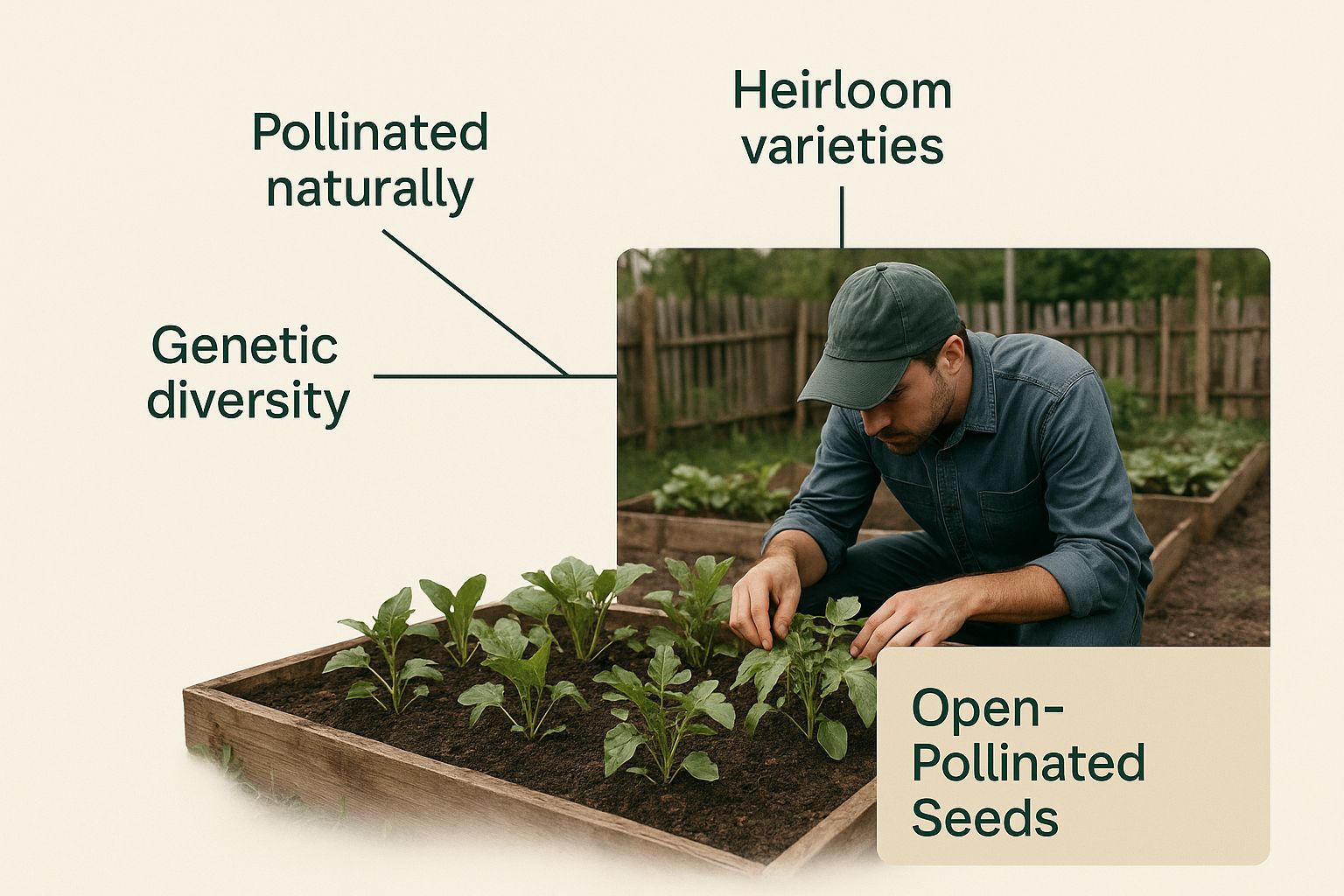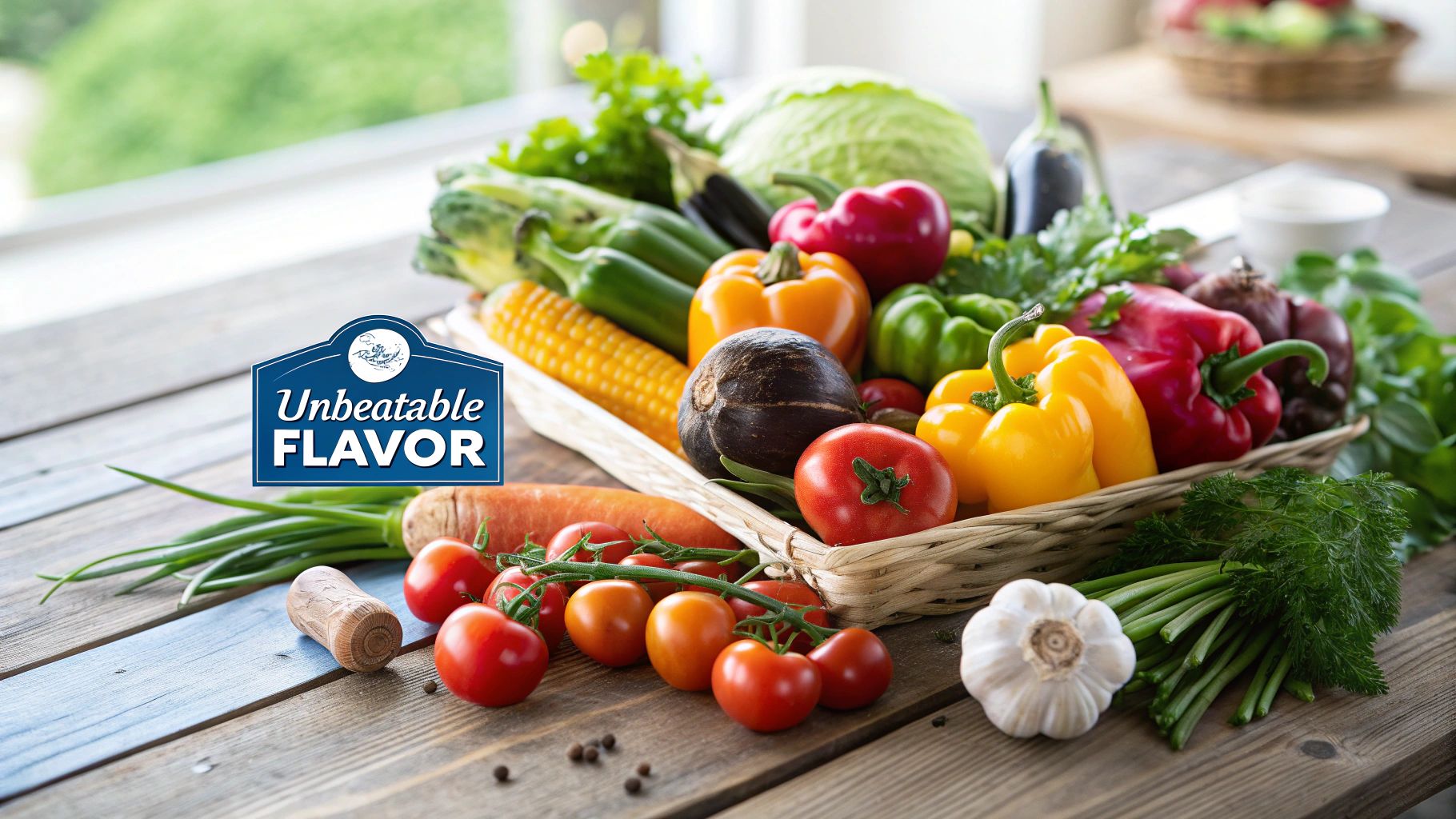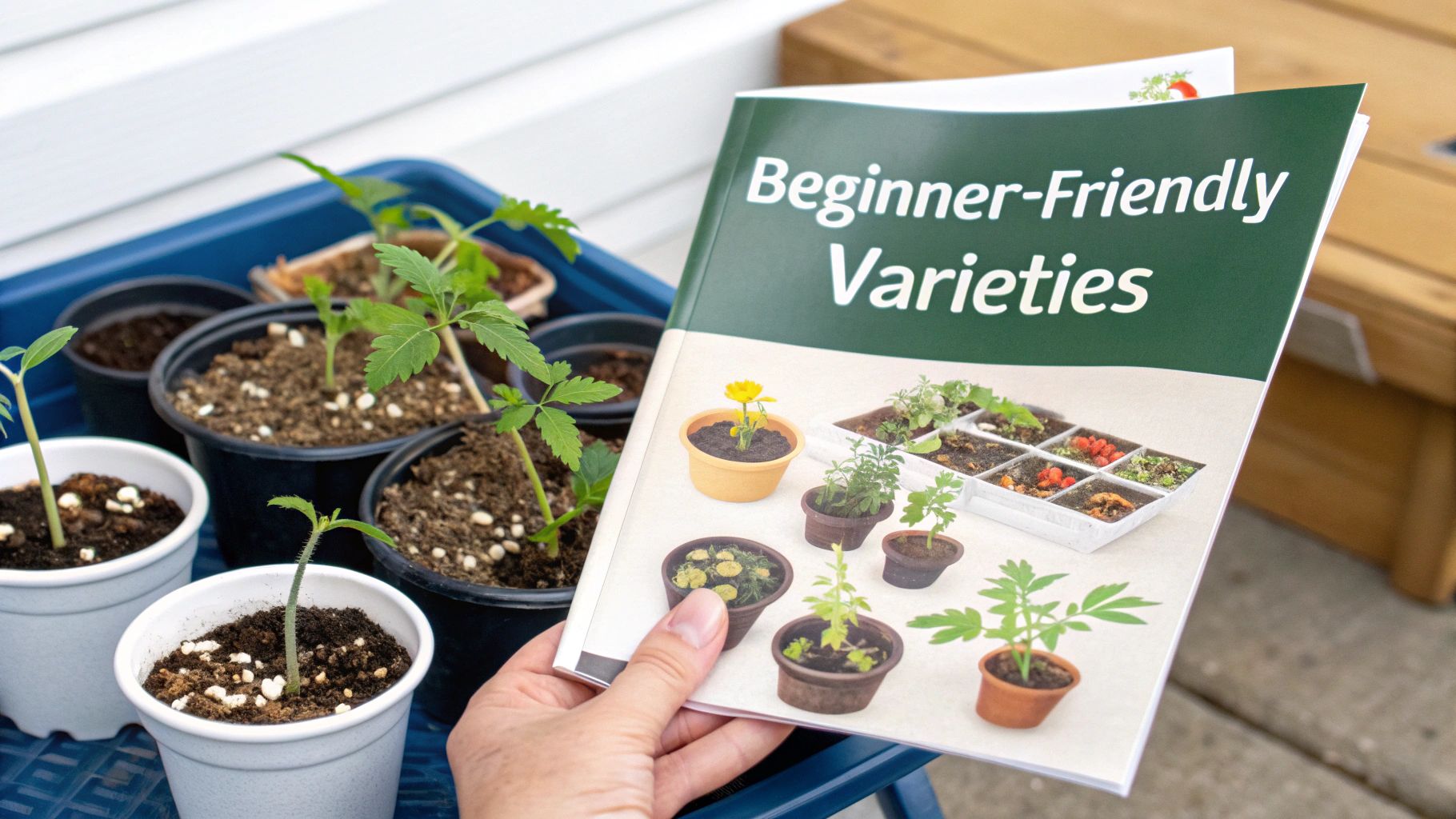
Think of heirloom seeds as living history. They're like a treasured family recipe, passed down through generations. If you save the seeds from a particularly delicious tomato or a stunningly beautiful flower, the plants you grow next year will be just as wonderful. This is the magic of heirlooms—they are time-tested and true.
To officially be called an heirloom, a plant variety generally needs a documented history of at least 50 years. Many are much older, with stories stretching back centuries.
The 5 Defining Traits of Heirloom Seeds
So, what really makes a seed an heirloom? It's more than just age. It’s a combination of history, genetics, and the way the plant reproduces. These are the qualities that gardeners have worked so hard to preserve, long before giant commercial farms became the norm.
At their heart, all heirloom seeds are open-pollinated. This means they rely on nature—insects, birds, wind, or even the gardener's hand—to pollinate them. This natural process is key to their stability.

Here are the five core characteristics that truly define an heirloom seed:
- A Rich History: As mentioned, they must have a lineage of at least 50 years, connecting them directly to gardeners of the past.
- Open-Pollinated Nature: Every heirloom is open-pollinated. This is non-negotiable! This is what allows them to produce seeds that will grow true-to-type. You can dive deeper into the differences between open-pollinated vs hybrid seeds in our detailed guide.
- Stable Genetics: When you save seeds from an heirloom plant, you can be confident that the next generation will have the same traits as the parent. This is called "breeding true."
- Unique Flavors and Appearances: Heirlooms were often saved for a reason—incredible taste, vibrant and unusual colors, or a perfect adaptation to a specific climate. These are the qualities often lost in modern varieties bred for shipping and shelf life.
- Cultural Significance: Many varieties carry stories with them, named for the families, people, or places that first grew and cherished them.
Heirloom vs Hybrid vs GMO Seeds at a Glance
When you're shopping for seeds, you'll likely come across a few different terms. It can be confusing, but this quick table breaks down the fundamental differences between the three main types.
| Attribute | Heirloom Seeds | Hybrid Seeds | GMO Seeds |
|---|---|---|---|
| Pollination | Open-pollinated (by nature) | Cross-pollinated (controlled) | Any pollination type |
| Seed Saving | Seeds "breed true" to parent | Seeds are unstable/not true | Often patented; saving is restricted |
| Genetic Makeup | Natural, stable genetic lines | A cross between two specific parent lines | Genetically modified in a lab |
Understanding these distinctions helps you choose the right seeds for your gardening goals, whether you're prioritizing flavor, uniformity, or the simple joy of preserving a piece of history.
The 3 Historical Stages of Heirloom Seeds
Heirloom seeds aren't just something you buy for your garden; they're living history. Think of them as a direct link to generations of farmers and gardeners who knew exactly what they were doing. They weren't just growing food—they were carefully selecting the best plants for incredible flavor, hardiness, and sometimes, just stunning beauty. These seeds were treasures, passed down through families and tight-knit communities.
Stage 1: The Age of Seed Saving
For centuries, these were the only seeds. They were the backbone of local food systems, traveling across oceans tucked into pockets or sewn into the hems of dresses. A bean that grew perfectly in a specific Italian village might find a new home in America, carrying with it the taste and heritage of the old country. This tradition of saving and sharing seeds meant that every community had food perfectly suited to their own little corner of the world.
Stage 2: The Shift to Commercial Seeds
Everything started to change in the 20th century with the rise of industrial agriculture. Suddenly, commercial hybrid seeds were everywhere. These were designed for one thing: uniformity. They grew plants that could be shipped long distances and would all look the same on a supermarket shelf. While these new hybrids often produced higher yields, that efficiency came at a steep price.
The age-old practice of farmers saving their own seeds began to fade, and with it, countless unique, locally-adapted plant varieties simply vanished.
It's estimated that a staggering 75% of crop genetic diversity was lost during the 20th century as farmers all over the world switched to these new, uniform varieties. That loss makes saving the heirlooms we still have more important than ever.
Stage 3: A Legacy Worth Saving
Today, planting an heirloom seed is about more than just growing a vegetable. It's an act of cultural preservation. When you plant a ‘Cherokee Purple’ tomato, for example, you’re not just growing a tomato; you’re cultivating a variety that is said to have been passed down from the Cherokee people.
You're connecting to a rich, unbroken chain of agricultural history. It turns your garden from a simple plot of land into a living museum, making sure these priceless genetic stories are around for the next generation to taste and enjoy.
9 Incredible Benefits of Growing Heirloom Plants
Choosing to grow heirloom plants in your garden is more than just a hobby—it's a conscious decision to cultivate flavor, history, and real food diversity. While the perfectly uniform vegetables at the supermarket have their place, they can't compare to the rich experience heirlooms offer. You're not just planting a seed; you're connecting with a story.
From taste that'll ruin you for store-bought produce to saving a little cash, the reasons to grow heirlooms are pretty convincing.

Let's dig into nine of the best benefits that might just make you a lifelong heirloom gardener.
2 Flavor and Nutrition Benefits
-
Unbeatable Taste: This is the big one. Heirlooms were passed down for a simple reason: they were ridiculously delicious. Modern produce is often bred for long shelf life and the ability to survive cross-country shipping. Heirlooms, on the other hand, were selected purely for their rich, complex flavors. One bite of a real 'Brandywine' tomato and you'll understand.
-
Higher Nutritional Value: It turns out that old-fashioned goodness often translates to better nutrition. Some research suggests that because heirlooms haven't been genetically tinkered with for commercial traits, they often retain higher levels of vitamins, minerals, and antioxidants than their modern counterparts.
3 Smart Gardening Benefits
-
Seed Saving for Self-Sufficiency: Here’s where heirlooms really shine. As open-pollinated plants, they "breed true," meaning the seeds you save from your harvest will produce the exact same type of plant next year. This simple act saves you money and moves you one step closer to a truly sustainable garden.
-
Adaptability to Your Local Conditions: A plant that has been grown in the same region for 50 or 100 years has learned a thing or two. Heirlooms often become naturally adapted to their local climate, soil, and pests, meaning they can thrive with less fuss and fewer chemical inputs from you.
By growing heirlooms, you're not just planting a garden; you're becoming a steward of genetic diversity. Each variety you cultivate is a vote for a more resilient and flavorful food system.
- Unique and Diverse Harvests: Are you bored with standard-issue red tomatoes and plain green zucchini? Heirlooms blow the doors off conformity. You can fill your garden and your kitchen with striped 'Tigerella' tomatoes, vibrant purple 'Dragon Tongue' beans, or charming little 'Ronde de Nice' squash. It makes gardening—and cooking—an adventure.
4 Environmental and Historical Benefits
-
Connection to History: Every single heirloom seed has a story. When you plant a 'Cherokee Purple' tomato, you're tending a piece of history that traces back to the Cherokee people. Gardening becomes a way to keep agricultural heritage alive and in the ground.
-
Increased Biodiversity: Planting a wide range of heirlooms is a direct contribution to biodiversity. Think of genetic diversity as nature's insurance policy. It helps protect our food supply from the widespread diseases and pests that can easily wipe out huge monoculture crops.
-
Better for Pollinators: The incredible variety in heirloom flower shapes, sizes, and bloom times creates a veritable buffet for bees, butterflies, and other pollinators. A diverse garden is a happy and healthy ecosystem.
-
A Known, Safe Food Source: When you grow your own heirlooms, you are in complete control. You know exactly what went into the soil and onto the plants. It's the ultimate way to provide safe, fresh, and chemical-free food for your family.
Why Seed Preservation Is So Important
Saving heirloom seeds isn't just a quaint gardening hobby. It's a critical mission to protect our agricultural future. Think of genetic diversity as nature's ultimate insurance policy. When we have a huge library of different genes in our food crops, we have the tools to solve problems we can't even predict yet.
This genetic toolkit is becoming more vital every year. As we face a changing climate, new plant diseases, and unexpected environmental stresses, the solution might be hiding in an old seed variety. A forgotten tomato's natural resistance to a new blight or an old corn’s ability to withstand drought could be exactly what we need to develop the resilient crops of tomorrow.
A Legacy at Risk
The situation is more urgent than you might think. The Food and Agriculture Organization (FAO) of the United Nations gives a sobering estimate: we lost an incredible 75% of crop genetic diversity during the 20th century. This happened as big agriculture shifted its focus to just a handful of high-yield, uniform commercial crops. You can dig deeper into this shift by exploring the comprehensive research from Grand View Research.
Thankfully, organizations like the Seed Savers Exchange are on the front lines, acting as guardians for what remains. They currently maintain a living library of over 20,000 heirloom varieties.
"Every time we lose a variety, we lose a unique set of genes—genes that we can't get back. Saving seeds is protecting a library of solutions for tomorrow."
When you decide to grow heirloom seeds, you're doing so much more than planting a garden. You're joining a worldwide movement to protect this irreplaceable heritage.
You become a keeper of history and a direct contributor to our future food security. Every single seed you save and plant is a powerful vote for a more diverse, sustainable, and resilient food system. If you're inspired to start, our guide on how to store seeds for the long term is a great next step.
7 Easy Heirloom Varieties for Your First Garden
Alright, you're sold on the idea of heirloom seeds but feeling a little overwhelmed by the choices? I get it. The best way to truly understand what all the fuss is about is to get your hands dirty and grow some yourself.
To make things easy, I’ve pulled together a list of seven absolute winners. These varieties are reliable, incredibly productive, and—most importantly—a total joy to grow and eat.

Think of this as your fail-proof shopping list. Starting with these classics takes the guesswork out of the equation and sets you up for an amazing first harvest full of flavor and history.
4 Vegetables with a Story
1. 'Brandywine' Tomato: If there’s one heirloom tomato everyone knows, it's the 'Brandywine'. Dating back to 1885, this is the benchmark for true tomato flavor. The big, pinkish-red fruits have a rich, complex taste that perfectly balances sweetness and acidity. For a deep dive, check out our guide on how to grow heirloom tomatoes.
2. 'Kentucky Wonder' Pole Bean: This American classic from the 1860s is a true garden workhorse. These plants love to climb and will reward you with a massive harvest of stringless, meaty pods. They're fantastic steamed fresh from the garden but also hold up beautifully for canning or freezing.
3. 'Black Beauty' Zucchini: First introduced in the 1920s, this is the dark, glossy zucchini that all others are compared to. It has a much richer, nuttier flavor than most modern hybrids and produces so prolifically you'll be leaving baskets on your neighbors' doorsteps.
4. 'Danvers 126' Carrot: Developed in Danvers, Massachusetts, way back in 1871, this carrot was specifically bred to handle the heavy, clay-rich soil common in New England. It grows to about seven inches long, with a deep orange color and a wonderfully sweet, crisp flavor that’s tough to beat.
3 More Must-Try Varieties
5. 'Marketmore 76' Cucumber: This is my go-to slicer for a stress-free harvest. Developed at Cornell University in 1976, it’s a modern heirloom known for its incredible productivity and built-in resistance to common cucumber diseases. It just grows.
6. 'Cherokee Purple' Tomato: You can't talk about heirlooms without mentioning this legend. The story goes that this variety was passed down from the Cherokee people. It’s famous for its unique dusky-rose color and an unforgettable rich, slightly smoky flavor that will spoil you for all other tomatoes.
7. 'Dragon Tongue' Bush Bean: Want to grow something that really turns heads? These Dutch heirlooms produce gorgeous creamy-yellow pods with bright purple streaks that look like they were painted on. They’re completely stringless, wonderfully tender, and their compact bush size makes them perfect for smaller gardens or even containers.
Your Top 4 Questions About Heirloom Seeds Answered
As you get into the wonderful world of heirloom gardening, a few questions always seem to come up. It's totally normal. Let's clear the air on some of the most common ones so you can plant with confidence.
1. What’s the Difference Between Heirloom and Organic?
This is probably the biggest point of confusion, and it’s a great question. People often use "heirloom" and "organic" interchangeably, but they describe two completely different things.
Here’s the simplest way to think about it: organic is how a plant is grown, while heirloom is what the plant is.
Organic is a growing method. It means the plant was raised without synthetic pesticides, herbicides, or fertilizers. You can grow an heirloom variety using organic methods, or you could grow it conventionally.
Heirloom, on the other hand, is all about the plant's genetics and history. It tells you that the seed comes from a long line of plants that have been passed down through generations.
The bottom line? You can buy an heirloom seed that isn't certified organic, and you can definitely buy a certified organic seed that's a modern hybrid. They aren't the same, but gardeners who care about one often care about the other.
This overlap in interest is a big reason the seed market is booming. The organic seed market alone is expected to jump from $4.82 billion to $12.25 billion between 2025 and 2034. If you're curious about this trend, you can get a deeper look by exploring the full organic seed market report on Precedence Research.
2. What Is the 50-Year Rule of Thumb?
What makes a seed an "heirloom"? Generally, the variety needs to have been around for at least 50 years. This isn't a hard-and-fast law, but it's a good benchmark that ensures the plant predates the era of modern, industrial hybridization that started after World War II.
3. Where Can You Find the Best Heirloom Seeds?
You probably won't find the most interesting heirlooms at your local big-box store. Your best bet is to look for specialty seed companies, dedicated online suppliers, or local seed swaps. These are the people who are passionate about preserving these unique varieties and can often tell you the story behind them.
4. Do All Heirlooms Grow the Same Way?
No, and it's important to know this. "Heirloom" is a huge category, not a single type of plant. Some varieties are incredibly productive and easy to grow, while others can be finicky or adapted to a very specific climate. Always read the descriptions and see what other gardeners in your zone say before you buy. It’s the best way to set yourself up for a fantastic harvest.
Ready to taste the difference for yourself? At Homegrown Garden, we’ve put together a special collection of authentic heirloom seeds, complete with detailed grow guides to help you succeed. Explore our collection and begin your gardening journey today!



